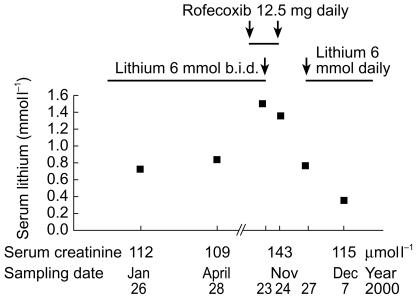A 73 year old man who has suffered from manic depressive illness for 40 years had continuous prophylactic treatment with lithium citrate since 1969. Over the past 6 years, the antidepressant lofepramine in daily doses between 70 and 140 mg had also been used due to episodic mild depression during the winter months. In 1994, he successfully underwent coronary bypass surgery and aortic valve replacement. Following surgery, chronic warfarin therapy was started. In addition, over the past 2 years his cardiovascular drug regimen was frusemide 40 mg daily, captopril 6.25 mg twice daily and sotalol 80 mg twice daily. Laboratory tests on a yearly basis for the past 13 years had shown values within age-corrected reference values for serum creatinine (100–120 µmol l−1) and Cr-EDTA clearance (61–82 ml min−1). The 12 h serum lithium concentrations ranged between 0.6 and 0.9 mmol l−1 over the same time period. However, lithium doses had been reduced over the past decade from 12 mmol (84 mg Li+) twice daily to 6 mmol (42 mg Li+) twice daily in order to keep the serum lithium concentrations within laboratory guidelines and to maintain a sustained theraputic effect.
In November 2000, the patient developed daytime somnolence and mild confusion, which was acute in onset. He was increasingly irritable and suffered from tremor as well as gait disturbances. A drug history revealed that he had been started on the cyclooxygenase-2 (COX-2) selective inhibitor rofecoxib 12.5 mg daily 9 days earlier due to pain from trochanteritis of the left hip. The patient was not taking any other medicines including over-the-counter drugs or herbal medicines. Roxfecoxib was chosen in order to avoid a possible drug interaction with warfarin. The pain from the left hip disappeared gradually within a few days; however, the patient in parallel also developed clinical signs of lithium intoxication. The acute 12 h serum lithium concentration was 1.50 mmol l−1 and the serum creatinine was 143 µmol l−1. Lithium and rofecoxib were withdrawn (all other drugs were continued) and the clinical signs resolved within 1 week. The serum lithium concentration returned to levels observed before the start of rofecoxib treatment and the lithium therapy could was restarted. However, the lithium maintenance dose was reduced to 6 mmol (42 mg Li+) daily with a proportional 50% decrease in the observed maintenance serum lithium concentrations. The serum lithium and creatinine concentrations prior to, during, and after this episode are shown in Figure 1.
Figure 1.
Serum lithium and creatinine concentrations before, during, and after lithium and rofecoxib co-administration.
Litium nephrotoxicity is well recognized and characterized by progressive combined glomerular and tubulo-interstitinal nephropathy [1]. NSAIDs that are nonselective inhibitors of COX are known to decrease renal glomerular filtration rate and increase lithium serum concentration when used concomitantly [2]. Less information is available on the potential nephrotoxicity of the recently introduced selective COX-2 inhibiting NSAIDs, although effects on renal function similar to those of nonspecific NSAIDs have been reported [3]. Moreover, case reports of reversible acute renal failure in patients with chronic renal insufficiency treated with COX-2 inhibitors have been published [4]. In line with the observations reported here, there has also recently been another report of increased serum lithium concentrations and clinical signs of mild lithium toxicity following concomitant use of lithium and rofecoxib [5].
In summary, the patient developed clinical signs of mild to moderate lithium intoxication, which was confirmed by laboratory data of increased serum lithium and creatinine concentrations. These observations occurred with the combined use of lithium and rofecoxib, and following dechallenge of both drugs, the clinical status and laboratory data returned to expected levels. Both these drugs have been associated with nephrotoxicity and it is consequently likely that the lithium intoxication was induced by concomitant administration of rofecoxib causing a reversible decrease in renal function. However, a more confirmatory re-challenge could not be performed for ethical reasons, and thus further observations are warranted for confirmation of the causal nature of the reported interaction.
References
- 1.Markowitz G, Radhakrishnan J, Kambham N, Valeri A, Hines W, D'Agati V. Lithium nephrotoxicity. A combined glomerular and tubulointerstitial nephrotoxicity. J Am Soc Nephrol. 2000;11:1439–1448. doi: 10.1681/ASN.V1181439. [DOI] [PubMed] [Google Scholar]
- 2.Finley PR, Warner MD, Peabody CA. Clinical relevance of drug interactions with lithium. Clin Pharmacokinet. 1995;29:172–191. doi: 10.2165/00003088-199529030-00004. [DOI] [PubMed] [Google Scholar]
- 3.Braiter C. Effects of nonsteroidal anti-inflammatory drugs on renal function: Focus on cyclooxygenase-2-selective inhibition. Am J Med. 1999;107:65S–71S. doi: 10.1016/s0002-9343(99)00369-1. [DOI] [PubMed] [Google Scholar]
- 4.Perazella M, Eras J. Are COX-2 selective inhibitors nephrotoxic? Am J Kidney Dis. 2000;35:937–940. doi: 10.1016/s0272-6386(00)70266-6. [DOI] [PubMed] [Google Scholar]
- 5.Sajbel TA, Carter GW, Wiley RB, et al. Pharmacokinetic effects of rofecoxib therapy on lithium. Pharmacotherapy. 2001;21:308. [Google Scholar]



